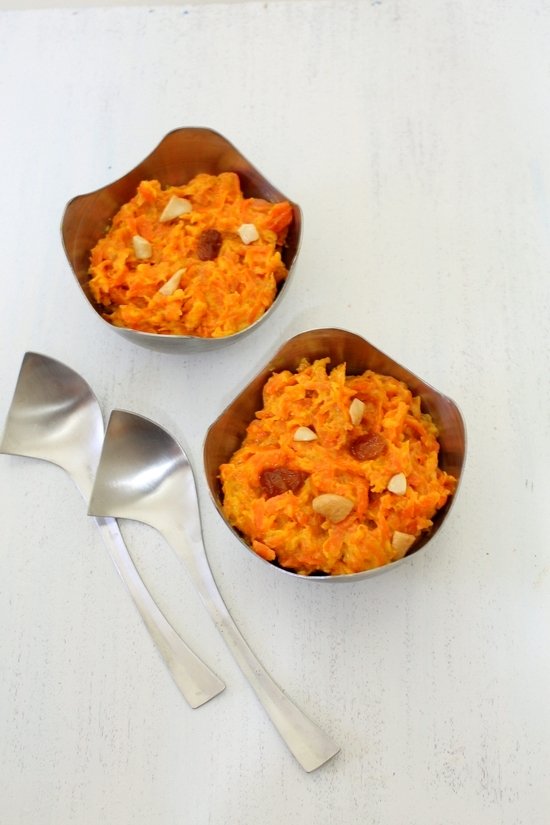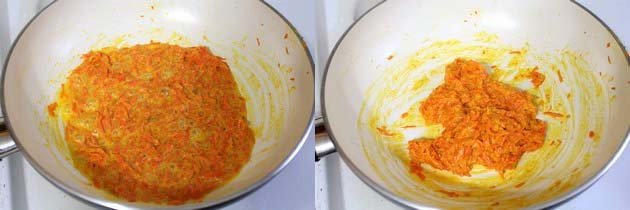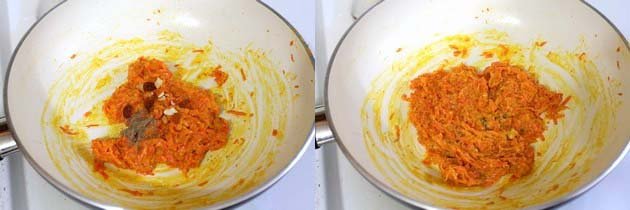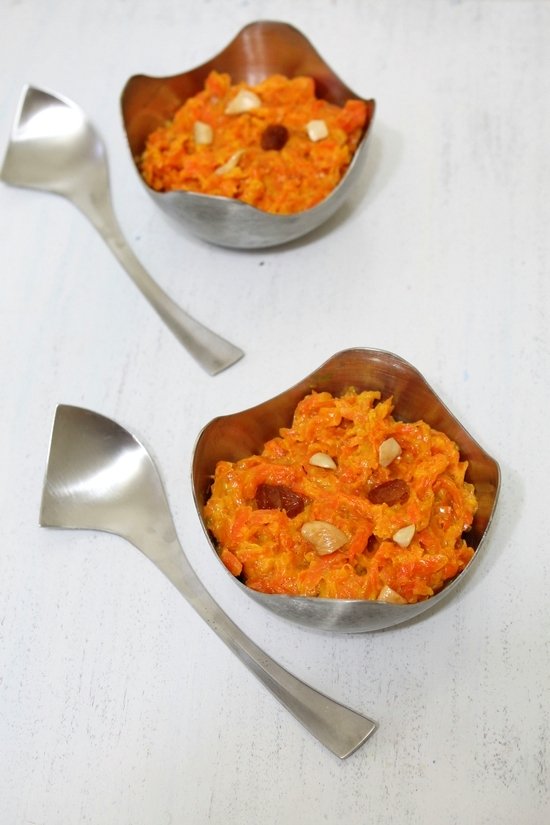If you’re craving something sweet, rich, and traditional but don’t have hours to spare, this quick Gajar Halwa recipe with condensed milk (or Milkmaid) is just what you need! Ready in just 15 minutes using only 4 main ingredients (plus garnishing), this recipe is a game-changer for busy festive days or last-minute dessert cravings.

You might wonder, “Is it really the same as the traditional gajar halwa?” The key difference is in the texture and how it’s cooked.
In the traditional method, grated carrots are slowly simmered in full-fat milk until it evaporates completely. This slow process forms tiny granules of milk solids, giving the halwa a slightly grainy, rustic texture. The process can take up to 2 hours, especially when preparing large quantities. It’s authentic and delicious—but definitely time-consuming.
On the other hand, this instant version with condensed milk is much quicker and gives a creamy, rich, and smooth texture. The condensed milk not only sweetens the halwa but also cuts down the cooking time dramatically without compromising on flavor. You still get that classic taste, just in a fraction of the time!
This shortcut version is also a great choice for beginners or those cooking in small batches. It’s ideal for festivals like Diwali, Holi, or Raksha Bandhan, and perfect for winter evenings when you’re craving something warm and comforting. Commonly called Gajrela in North India, this carrot halwa is a beloved winter treat, often made in large batches and stored in the fridge for days. It stays good for up to a week, making it a convenient make-ahead dessert that’s always ready to serve.
Warm it slightly before serving, top with ghee-roasted nuts, and enjoy every creamy bite!
Ingredients For Gajar Halwa:
- 1 tablespoon Ghee (Clarified Butter): Use pure desi ghee for that authentic aroma and richness. Ghee not only enhances the flavor but also helps roast the carrots to bring out their natural sweetness. You can increase it slightly if you prefer a richer halwa.
- 2 cups Carrots, grated: Fresh, tender, and juicy red carrots (preferably the seasonal ones available in winter) work best for this recipe. They cook quickly and have a natural sweetness, making them ideal for halwa. Use a medium grater—not too fine or coarse—for perfect texture.
- ½ cup Milk: Just enough milk is added to soften the carrots and start the cooking process. Since condensed milk will follow, we don’t need a large quantity here. Use full-fat milk for a creamy consistency.
- ¼ cup Sweetened Condensed Milk: This is the key ingredient in the quick version—it cuts down the cooking time drastically while bringing in rich sweetness and a smooth, creamy texture. Feel free to adjust the amount based on how sweet you like your halwa—add more for richness or reduce it for a milder taste.
- 1 tablespoon Cashew Nuts, chopped: Cashews add a rich crunch and nutty flavor. You can lightly roast them in ghee for extra depth.
- 1 tablespoon Raisins: Raisins add a gentle, natural sweetness along with a soft, chewy bite. Cook them along with the halwa so they absorb moisture and become plump and juicy.
- ¼ teaspoon Green Cardamom Powder: Freshly ground cardamom adds a warm, aromatic touch that enhances and unifies all the flavors in the halwa beautifully. A small amount goes a long way in enhancing the overall aroma and taste.
Step-by-Step Instructions:
1) Heat the ghee:
Start by heating ghee in a heavy-bottomed pan over medium heat. Once the ghee is hot and aromatic, add the freshly grated carrots. Stir well to coat them evenly in ghee. This initial roasting brings out the natural sweetness of the carrots and enhances the overall flavor of the halwa.
2) Sauté the carrots:
Continue to cook the carrots for 7–8 minutes, stirring at intervals. As they cook, their color will deepen slightly, and their volume will reduce as moisture escapes. You’ll also notice a shift in aroma—the raw scent disappears, replaced by a mellow, earthy fragrance.
3) Add the milk:
Pour in the full-fat milk and mix thoroughly. The milk softens the carrots even more and forms a rich, creamy foundation for the halwa. It also adds richness and a slightly creamy background to balance the sweetness.
4) Let it simmer:
Allow the mixture to simmer gently. Stir now and then to keep the mixture from sticking or burning at the bottom of the pan. The milk will slowly begin to reduce and get absorbed by the carrots.

5) Reduce the mixture:
After 2–3 minutes, the milk should be mostly evaporated. You’ll see the carrots turn soft and glossy, and the mixture will start pulling away from the sides of the pan—a clear sign it’s time for the next step.
6) Add the condensed milk:
Now pour in the sweetened condensed milk. Stir it thoroughly into the cooked carrots, making sure it blends smoothly without any lumps. This instantly transforms the texture, making it creamier and giving the halwa a smooth, melt-in-mouth consistency.

7) Cook it down:
Allow the mixture to simmer on medium-low heat, stirring at intervals to prevent sticking. As it thickens, it will come together like classic halwa, and you may notice ghee starting to separate from the sides—a sign it’s almost ready.
8) Final consistency check:
Once the halwa turns thick, cohesive, and glossy with no excess moisture, turn off the heat. The carrots should be fully tender, and the halwa should hold its shape when scooped.

9) Add flavor and texture:
Add the chopped cashews, plump raisins, and a sprinkle of freshly ground cardamom powder, then mix well to infuse the halwa with flavor and texture. The cashews offer a lovely crunch, the raisins plump up and add a soft, chewy sweetness, and cardamom lends a warm, fragrant note that ties everything together beautifully.
10) Mix and rest:
Give the halwa a final mix, ensuring all the ingredients are well incorporated. Allow the halwa to sit for a few minutes so the flavors can meld beautifully before serving. This helps the flavors settle and intensify.

Expert Tips For Gajar Halwa:
1. Carrot Selection Matters:
Always choose fresh, tender, and juicy red carrots—especially the desi variety available in winter. They offer the best natural sweetness and vibrant color, which enhances both flavor and appearance. If red carrots are out of season, orange carrots can be used as an alternative, though the taste may be slightly different.
2. Adjust Sweetness Mindfully:
Since sweetened condensed milk already contains a good amount of sugar, make sure to taste the halwa before adding any extra sweetener. If you have a particularly sweet tooth, a spoonful of sugar can be added at the end to adjust. This way, you avoid making it overly sweet.
3. Use Full-Fat Milk for Creaminess:
Even though you’re using condensed milk, adding a small amount of full-cream milk at the beginning of the cooking process gives the halwa a richer, more traditional taste and smoother consistency.
4. Don’t Skip the Cardamom:
A touch of freshly ground green cardamom powder transforms the halwa. Its warm, floral aroma enhances the overall flavor profile and adds a classic Indian dessert note that’s hard to replicate with any substitute.
5. Ghee Makes All the Difference:
Even a small amount of ghee adds authentic richness and enhances the deep, traditional flavor that makes halwa truly special. It also helps roast the carrots and release their sweetness. Avoid using oil as it won’t deliver the same result.
6. For a Richer Touch:
To make the halwa extra rich and festive, you can mix in a few tablespoons of khoya (mawa) toward the end of cooking for added creaminess and depth. It makes the dessert denser, creamier, and even more luxurious.

Serving Suggestions:
1. Serve it warm for cozy comfort:
Enjoy this gajar halwa fresh off the stove, served warm in bowls or small katoris. It’s particularly soothing on chilly winter evenings, as the richness of ghee and the natural sweetness of carrots offer a warm and comforting dessert experience.
2. Serve it chilled for a firmer texture:
Prefer a cold dessert? Let the halwa cool down completely, then refrigerate it for a few hours until nicely chilled. Chilling gives it a firmer, rich, fudge-like texture. This version is great for those who enjoy a more set, biteable halwa.
3. Add festive garnishes:
Dress up your Gajar Halwa with slivered almonds, chopped pistachios, or even a sprinkle of edible silver leaf (varak) for a festive touch. A few strands of saffron soaked in warm milk can also be added on top for added aroma, color, and indulgence—especially for Diwali, Holi, or Raksha Bandhan celebrations.
4. Create a fusion dessert:
Take things up a notch by pairing warm gajar halwa with a scoop of vanilla ice cream. The contrast of hot and cold is not only delightful but turns this traditional sweet into an irresistible fusion dessert, perfect for dinner parties or modern Indian menus.
5. Ideal for gatherings and make-ahead:
This Gajar Halwa isn’t just delicious, it’s practical too. It can be prepared in advance and stored in the fridge for 5 to 6 days in an airtight container. Simply reheat before serving, or enjoy cold depending on your mood. It’s a crowd-pleaser for family get-togethers, festive pujas, or potlucks.
